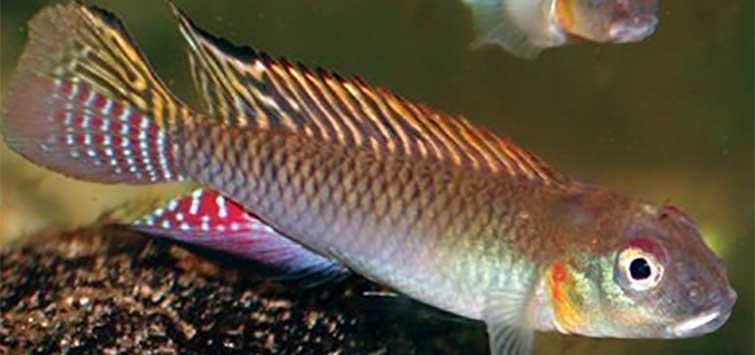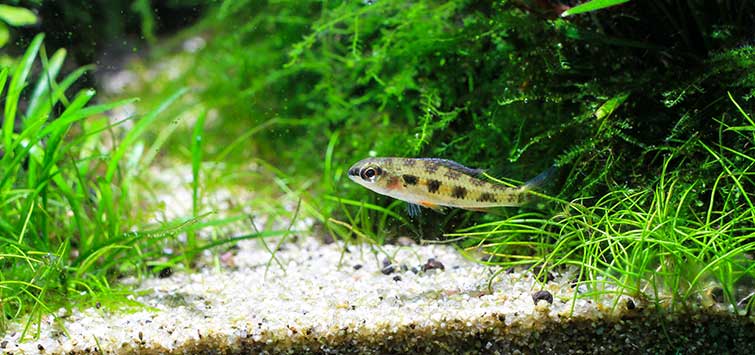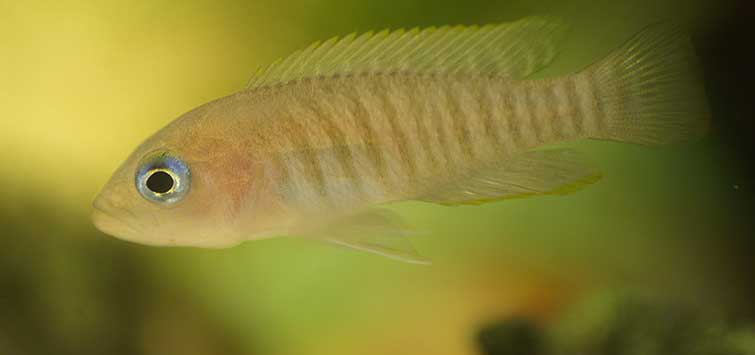Nanochromis splendens: A Splendid Discovery
Author: Gary Elson
A rare dwarf cichlid hailing from the Congo River, the diminutive Nanochromis splendens surpasses its reputation as being a wonderful hide-and-seek cichlid that amazes hobbyists with its curious behaviors.
Splendid splendens
The small African dwarf cichlid Nanochromis splendens certainly lives up to its Latin name—it is truly splendid! However, as it has been hinted at for decades, it’s also a fish of mystery and has only just made it into the dwarf cichlid hobby. In my view, it’s a species worth waiting for.
History
This fish, from the Congo River, was first described in 1976. It was seen at the edge of some of the many rapids that make the river such an imposing waterway. The idea that there was a dwarf cichlid out there with blue, yellow, red, and orange markings has taunted aquarists for more than 30 years. What would this little cichlid look like up close? Would we ever see it?
The Import Report
When TFH “Import Report” columnist and importer Oliver Lucanus informed me that he had some coming in, I jumped in my car and headed his way. I consider myself to be a helpful sort of aquarist, and all importers could use an extra hand unpacking boxes of rare cichlids from Africa.
As I closely examined the fish while they were still in their shipping container from the Democratic Republic of Congo, I knew I was about to embark on an amazing fishkeeping adventure. One of the great hide-and-seek cichlids of the hobby had made it to my home base.
I brought home two pairs from that wonderful shipment, along with a bunch of equally mysterious new arrivals. I approached the contents of that delivery like a kid in a candy store, but my new splendens seemed the sweetest find.
Appearance and Care
The first striking thing about these fish was how slender they were. Reports described them as being the most slender member of their group, but I was still surprised by their appearance. With a diet heavy in live food, they were soon to take on a chunkier shape more like that of other Nanochromis species. I concluded their natural environment must be a tough one.
I set the fish up with Procatopus similis (lampeyes found in Cameroon) as tankmates in two different 3-foot- (1-meter-) long tanks. The geographic origin of these companion fish was wrong, but lampeyes are small fish that don’t prey on fry, and they like moving water.
Behavior and Breeding Pairs
I believe it’s always better to err on the side of too much room, even for a tiny 2-inch (5-cm) dwarf cichlid. The other Nanochromis I had kept in the past (N. parilus, N. transvestitus, and N. teugelsi) had not been especially aggressive, but I have learned never to make assumptions about a “new” cichlid.
My caution paid off. While the N. splendens were delightful in their color, their behavior was not as charming. Both pairs settled in quickly, but after a few quiet weeks they began to fight. The larger males dominated and took to parading in front of the glass with their colors amped up and their fins out like sails. The possibly even more beautiful females would poke their noses out just enough that I knew they were still alive. Every appearance would draw a galloping charge from the ever-vigilant males.
Charging Males
I’ll admit that I was worried. I had two pairs, and they were both in the same state. The males were charging the females every time they appeared, and every day they seemed to appear less and less. I could see the females were alive, but there were no ragged fins or wounds to indicate they were catching them. I was afraid I’d end up with two hyper males and sad memories of a fish species I had really wanted to keep and breed.
Peaceful Swimming
Suddenly, they were swimming side by side as relaxed as could be, though there was no courtship or display yet. After three weeks of absolute mayhem, I had two pairs of calm and easygoing dwarf cichlids patrolling the front of the glass, showing off, and looking good.
Interestingly, Jaroslav Vojta, a European aquarist with whom I was corresponding online, reported a similar period of violent aggression with his N. splendens pairs. Sometimes when fishkeepers get a new fish and report on it, we have a tendency to think what happens in our tank is “what happens.” We generalize from limited experience. There’s always a doubt in the back of my mind about that, as we all offer different water, different conditions, and different setups that can influence behavior.
In this case, it seemed pretty clear. It’s a wonderful fish, but it may take you on a white-knuckle ride when you first introduce a pair to each other.
Spawning Behavior
While I was contemplating this, the fish had started courting heavily and digging lightly. Neither pair used the breeding caves I had supplied. Past experience with N. splendens told me they liked to excavate under flat rocks, so I had buried low caves in the sand for them to empty out. As a second choice, I also added coconuts that were cut in half with small holes drilled through.
Spawning Locations
Both pairs chose overhangs that were shaded but almost in the open. One spawned under a gnarled piece of root wood at the back of the tank, and the other chose a rock structure I had made for the female to hide in, although I had no idea it would be suitable for spawning. Both spots were just off the edge of the main flow from the filter.
Guarding
Once the fish were guarding, the game changed again. These previously sociable cichlids became very secretive. They guarded their young closely but didn’t harm the companion fish. They had somehow communicated the idea that one-third of the tank was not a good tourism destination, and the lampeyes seemed to understand that perfectly.
Surprises
I admit that both pairs had me confused. The egg laying was so cautious and the guarding was so discrete that it was hard to time things out. Both pairs eventually brought out their young, but disaster struck for one of them. I came home from work to find the parents dead and the fry vanished. None of the other fish in the tank were affected.
The surviving pair had a tiny brood of seven fry. Three weeks later, I noticed the male was guarding the fry exclusively, and the female seemed to have a new batch of eggs. I removed the seven fry just before the next hatching.
Fry Development
The beautiful N. parilus is one of the fastest growing cichlids I have ever raised. This species astonished me with its rush to become an adult. N. splendens did not appear quite as precocious as N. parilus under my tank conditions, though it was not a slow grower either. The young splendens grew steadily and moved in peaceful social groupings along the bottom until their colors began to blossom. At that point, the previously calm groups exploded and dominant males developed. Still, there were no deaths from this unpleasant aggression, and after a rough sorting out period, the groups seemed calm together.
Physical Changes
N. splendens took off at about two months, but their colors came much more slowly than their body size. At 1½ inches (4 cm), they were nice but nondescript. The base colors were mostly brown. With age, the blue began to dominate and the strong fin colors began to appear. At a small size, it seemed like a fish that would be pretty but not stunning. However, you will be pleasantly surprised as the red, orange, and yellow colors lock in over the deepening blue as the fish matures.
In the Spawning Tank
Back in the spawning tank, things got really interesting. Jaroslav Vojta had reported larger spawns producing 50 or so fry, and I was feeling jealous. On my second try I got 30 fry, but I also noticed some intriguing behavior. It appeared that the parents exercised tight control over free-swimming fry. I assume this behavior has evolved due to the challenges of keeping small fry grouped together in quick moving water.
The seven young I had removed to a tank away from their parents (four males, three females) became quite bold in their hunting low in the water column, but the second and third batches had shown no wish to rise more than an inch (2.5 cm) from the bottom or from the sheltered side of the tree root. I had never seen one swim higher than the level at which the guarding parent was hovering.
Pairing Results
While the brood care was superb, the pair didn’t always work together. My male claimed an area on the opposite side of the tank, again, right of the edge of the filter outflow. He began to raise half a brood on his own.
When they spawned again, all of the older fry went with him. The female guarded the eggs, the larvae, and the young free swimmers largely on her own, while the male was occupied with his older group. I thought I had removed the second batch, but some escaped in the heavily planted aquarium. With most dwarf cichlids, those escapees would be doomed because the parents would kill them to protect their younger siblings. That’s not what I saw here, and it raises some questions.
Future Plans
My next plan is to put three pairs of juveniles into a larger 75-gallon (284-liter) tank. It will have a slightly acidic pH and moderately soft water (my local tap water). I will keep it at 78°F (26°C) and run two filters with strong outflows spaced along the back. I’m going to build some “islands” surrounded by open sand using root wood and rocks, but I will also set up the corners as refuges for fry.
First, with the luxury of having multiple pairs to work with, I will see if the pairs can coexist in one tank. If so, I expect they will follow the pattern and place their eggs where I can’t see them. They are very good at that.
I want to see if the pairs will form a species “colony” in the tank. I suspect they may well tolerate their fry and allow them to grow up in the tank with them. I don’t know if they will form a social grouping like some of the Lake Tanganyikan cichlids in which older fry help care for their siblings. I have seen no signs of that, although my anxious fry stealing could have ruined a perfectly amazing show. There’s only one way to find out.
Worth the Wild Ride
So, clearly, this article doesn’t provide all the answers. It may take years of aquarists keeping this wonderful little cichlid in a variety of setups before we can all compare notes and sort out patterns. If you have the opportunity to keep any Congo River region cichlids, such as Nanochromis, Congochromis, Steatocranus, Teleogramma, or other mysteries found in this magnificent region, jump on the bandwagon. It’s a fun place to be!

.png?h=595&iar=0&w=2781&hash=5FD5E69473BCC22199FBFA2FB71B6033)



